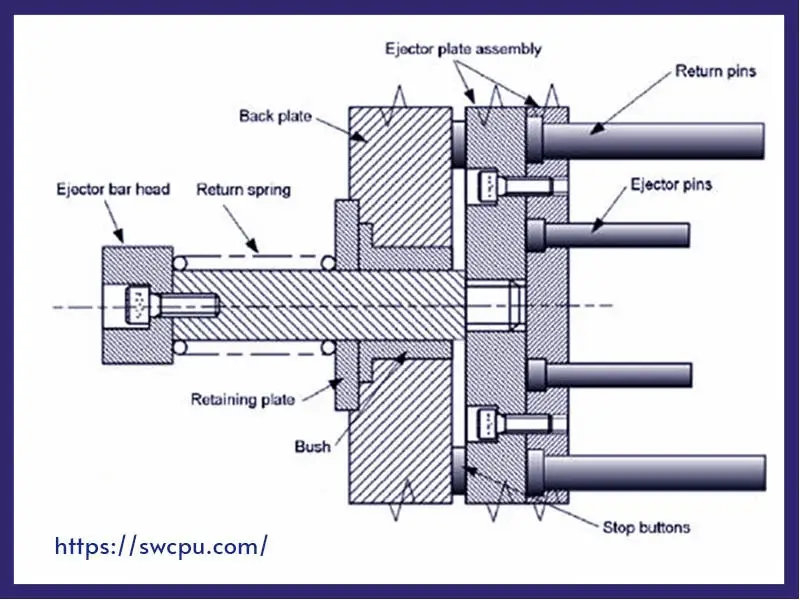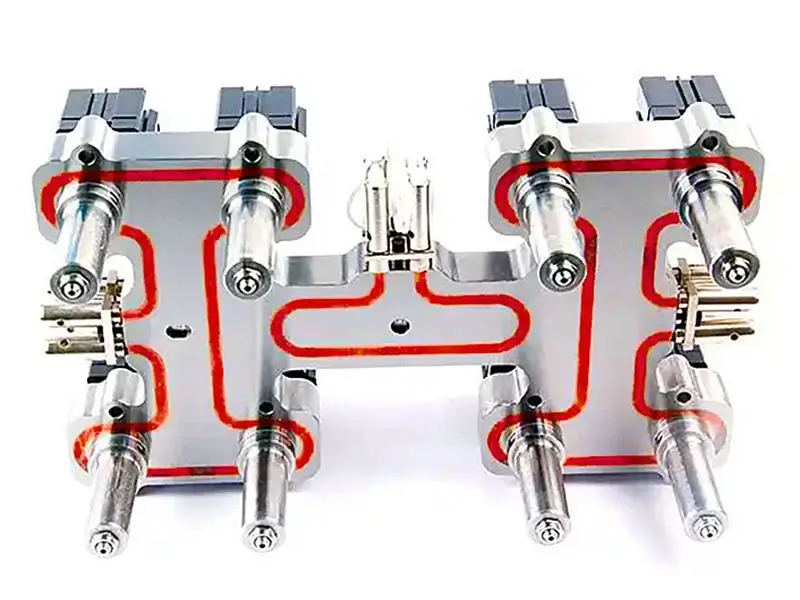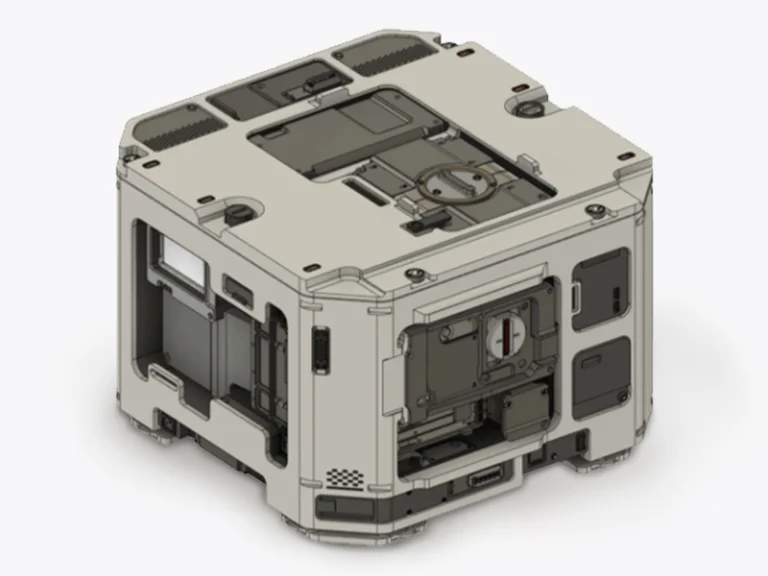The ejection system in injection molding is a crucial component of this process, and it is responsible for removing the finished part from the mold once it has cooled and solidified. This system ensures that parts are produced quickly, efficiently, and without damage. In this post, we will explore the importance, components, and workings of the ejection system in injection molding.
What is the Ejection System in Injection Molding?
The ejection system in injection molding is a critical component designed to remove the molded part from the mold once it has cooled and solidified. After the molten plastic is injected into the mold and forms the desired shape, the part needs to be released efficiently without damage. It is the last step of the injection molding process. The ejection system accomplishes this by pushing the part out of the mold using various mechanisms, ensuring a smooth and efficient production process.
Functions of the Ejection System in Injection Molding
The ejection system in injection molding serves the critical function of removing the solidified plastic part from the mold cavity after cooling. Its main functions are:
Ejecting the Part: The primary function is to eject or demold the solidified plastic part from the mold cavity without causing any damage or defects. This is achieved through various ejection mechanisms like pins, sleeves, blades, valves, or stripper plates/bars.
Preventing Deformation: The ejection system must apply the ejection force evenly and controlled to avoid deformation, warping, or cracking of the molded part, especially for thin-walled or intricate geometries.
Accommodating Part Design: The type and configuration of ejection components (pins, sleeves, blades, etc.) are selected based on the part design, size, shape, and features like undercuts, ribs, bosses, or through-holes to ensure effective ejection.
Enabling Automation: The ejection system is designed to operate automatically and synchronized with the mold opening and closing, enabling efficient and consistent part removal in each molding cycle.
Facilitating Venting: Some ejection components like sleeves can improve venting efficiency by providing additional venting channels, preventing defects like burn marks or short shots.
Ensuring Surface Quality: Proper ejection system design and maintenance prevent defects like ejector pin marks, scratches, or drag marks on the molded part surface, ensuring good aesthetics and quality.
Key Components of the Ejection System in Injection Molding
Ejector Pins
Thin rods that directly push the molded part out of the mold cavity. The number and location depend on the part shape and size. Positioned strategically to apply even pressure and avoid part deformation.
Ejector Plates
Plates that hold and move the ejector pins. Ensure synchronized movement of multiple ejector pins.
Ejector Sleeves
Hollow cylindrical sleeves used in combination with a pin to eject parts with circular through-holes or blind holes. Provides uniform ejection force around the core pin.
Ejector Rods
Connect the ejector plates to the mechanism that applies the ejection force. Transfer the force needed to push the ejector plates and pins.
Return Pins
Ensure that the ejector pins return to their original position after ejection. Help reset the system for the next molding cycle.
Ejector Guide Pins
Guide and align the movement of the ejector plates and pins. Prevent misalignment and ensure smooth operation.
Ejector Bushings
Provide a bearing surface for the ejector pins and guide pins. Reduce wear and tear, enhancing the durability of the system.
Hydraulic or Pneumatic Cylinders
Provide the necessary force to move the ejector system. They are used for automated or mechanical ejection systems.
Ejector Plate Stops
Limit the movement of the ejector plates to prevent over-travel. Ensure precise control of the ejection stroke.
Springs
Assist in returning the ejector system to its starting position. Provide additional force to ensure complete ejection of the part.

Types of Ejection Systems in Injection Molding
The ejection system in injection molding can be tailored to suit different types of molded parts and specific requirements of the molding process. Here are the main types of ejection systems:
Pin Ejection System in Mold
Description: Uses ejector pins to push the part out of the mold cavity.
Applications: Commonly used for simple parts with flat surfaces.
Advantages: Simple and cost-effective; easy to implement and maintain.
Disadvantages: Can leave pin marks on the part surface; may not be suitable for complex geometries.
Blade Ejection System in Mold
Description: Utilizes thin blades instead of pins to eject the part.
Applications: Suitable for parts with large, flat surfaces or thin-walled sections.
Advantages: Provides uniform force over a larger area; reduces the risk of part deformation.
Disadvantages: More complex and expensive than pin ejection; blades can be prone to damage.
Sleeve Ejection System in Mold
Description: Uses hollow sleeves to eject parts, especially those with cylindrical or tubular shapes. Provides uniform ejection force around the core pin.
Applications: Ideal for ejecting parts with central holes or cylindrical features.
Advantages: Provides support around the part perimeter; reduces the risk of damage to delicate features.
Disadvantages: More expensive and complex to design and implement.
Stripper Plate/Bar Ejection System in Mold
Description: A plate or bar that pushes against the bottom or periphery of the molding, typically used in conjunction with ejector pins.
Applications: Suitable for parts with large surface areas and complex geometries.
Advantages: Provides even force distribution; reduces the likelihood of part deformation.
Disadvantages: More complex and costly; requires precise alignment and maintenance.
Air Ejection System in Mold
Description: Uses compressed air to blow the part out of the mold cavity.
Applications: Suitable for lightweight parts or those with intricate details that are prone to damage by mechanical ejectors.
Advantages: Non-contact ejection method; reduces the risk of surface damage.
Disadvantages: Less forceful than mechanical methods; may not be suitable for heavier parts.
Hydraulic Ejection System in Mold
Description: Employs hydraulic cylinders to provide the ejection force.
Applications: Used in heavy-duty molding operations requiring high ejection force.
Advantages: Provides high force and precise control; suitable for large and complex parts.
Disadvantages: Expensive and requires more maintenance; involves complex setup.
Pneumatic Ejection System in Mold
Description: Utilizes pneumatic cylinders to eject parts.
Applications: Suitable for medium-duty applications requiring moderate ejection force.
Advantages: Provides controlled and adjustable force; cleaner operation compared to hydraulic systems.
Disadvantages: Less forceful than hydraulic systems; may not be suitable for very heavy parts.
Ejection System Types Selection Considerations in Injection Molding
Selecting the appropriate ejection system type for injection molding is critical to ensuring efficient, reliable, and high-quality part removal. Here are key considerations to guide the selection process:
Part Geometry and Complexity
Simple Shapes: Pin ejection is often suitable for simple parts with flat surfaces.
Complex Geometries: For parts with intricate details, or thin walls, consider stripper plates, blade ejection, or custom systems to provide even force distribution and prevent damage.
Cylindrical or Tubular Parts: Sleeve ejection works well for parts with central holes or cylindrical shapes, providing even support and reducing the risk of damage.
Undercuts and Draft Angles Parts: Parts with undercuts or insufficient draft angles may require specialized ejection systems like angled pins, sleeves, or stripper plates.
Large Part Size and Wall Thickness: Larger and thicker-walled parts may require larger diameter pins, valve ejectors, or air ejection systems to provide sufficient force without deformation.
Ejection Force Requirements:
Parts with thin walls, ribs, or varying thicknesses need an ejection system that distributes force evenly to prevent warping or cracking. Stripper plates, air ejectors or multiple pins/sleeves are used for such cases.
Material Properties
Type of Material: Different materials have varying shrinkage rates and adhesion properties. For example, rubbery or sticky materials may require air ejection to prevent sticking and reduce damage.
Surface Hardness: Harder materials can handle mechanical ejection methods like pin ejection, whereas softer materials might need more gentle ejection techniques.
Surface Quality Requirements:
For stringent surface quality needs (e.g. transparent or decorative parts), the ejection system should be located on hidden surfaces to avoid marks.
Cost and Budget Considerations
Initial Investment: Pin ejection is generally less expensive, while hydraulic and pneumatic systems require a higher initial investment.
Operating Costs: Consider long-term operating costs, including maintenance and potential downtime. Hydraulic and pneumatic systems typically have higher maintenance needs.
How to Optimize Ejection System Performance?
To optimize the performance of the ejection system in injection molding, several factors need to be considered:
Proper Ejector Pin/Sleeve Sizing and Placement
Ejector pins should be sized appropriately based on the part geometry, wall thickness, and ejection force required to avoid deformation or damage.
Larger diameter pins are preferred for higher ejection forces and rigidity.
Pins/sleeves should be placed at robust areas of the part like ribs, flanges or thick sections to distribute the ejection force evenly.
Placement on thin-walled sections should be avoided to prevent distortion or marking.
Adequate Venting and Air Channel Design for Air Ejection
Air channels should be strategically located and sized to provide uniform air pressure distribution around undercuts, ribs or bosses.
Proper venting is crucial to allow air to escape and break the vacuum between the part and cavity during air ejection.
The number, size, and location of air vents depend on the part geometry and complexity.
Timing and Synchronization of Ejection Sequence
The ejection sequence should be timed precisely to allow sufficient cooling and solidification before ejection.
Premature ejection can cause deformation or sticking of the hot, soft part.
Synchronization of mechanical ejectors (pins, sleeves) with air ejection is important for efficient part removal.
Maintenance and Troubleshooting Common Ejection Issues
Regular inspection and maintenance of ejector pins, sleeves, and plates is necessary to prevent wear, seizing, or misalignment.
Worn ejector components can cause marking, flash, sticking, or incomplete ejection.
Common issues like flash at parting lines, vacuum pockets, or deformation should be analyzed and the ejection system optimized accordingly.
Conclusion
The ejection system plays a critical role in the injection molding process, ensuring the safe and efficient removal of the solidified plastic part from the mold cavity. Proper design and selection of the ejection system components are essential to prevent defects, maintain part quality, and maximize production efficiency.
With a well-designed ejection system in injection molding, manufacturers can minimize defects like deformation, cracking, scratches, or ejector marks, ensuring consistent product quality and reducing waste.




